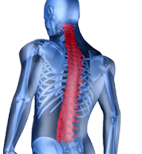Thoracic Radiofrequency Ablation (RFA)
What are Thoracic Facet Joints?
Facet joints connect the vertebrae (the bones of the spine) and help guide the spine during movement. The thoracic region of the spine contains twelve vertebrae and is located in the mid back.
Facet joints are found on both sides of the spine. Each is about the size of a thumbnail. Thoracic facet joints are named for the vertebrae they connect and the side of the spine where they are found. The T7-8 facet joint, for example, joins the 7th and 8th thoracic vertebrae.
Thoracic Facet Joint Pain
Thoracic facet joint pain is a result of injury, either to the cartilage inside the joint or the connecting ligaments surrounding the joint. Pain from an injured lumbar facet joint may range from muscle tension to more severe pain. Depending on which facet joint is affected, the pain may occur in an area in your mid back.
What is Thoracic RFA?
During this procedure, radiofrequency energy is used to disrupt function of a thoracic medial branch nerve, so that it can no longer transmit pain signals from an injured facet joint.
Procedure Detail
Post RFA Procedure
After the procedure, you may experience some muscle soreness for a few days. If so, you may want to apply ice or a cold compress to the affected area. Do not drive for the remainder of the day. Please have an adult drive you home or accompany you in a taxi or other public transportation. Depending on how you feel, you may resume normal activities and return to work the following day. You may feel sore for one to four days. This is normal, and may be caused by muscle and nerve irritation. Your back may feel numb, weak, or itchy for a couple of weeks. Be patient, as full pain relief normally takes two to three weeks.
How long can I expect pain relief?
You may have pain relief for 6-12 months. Nerves regenerate after an RFA, but how long this takes varies. Your pain may or may not return when the nerves regenerate. If it does, another RFA can be done.



